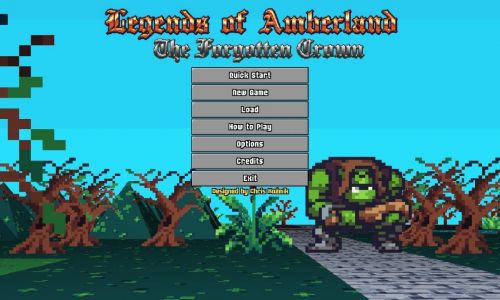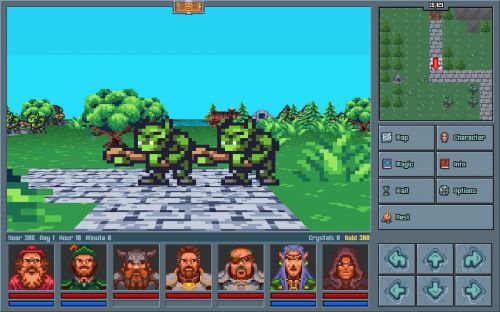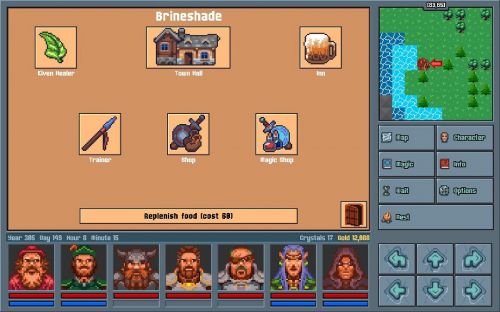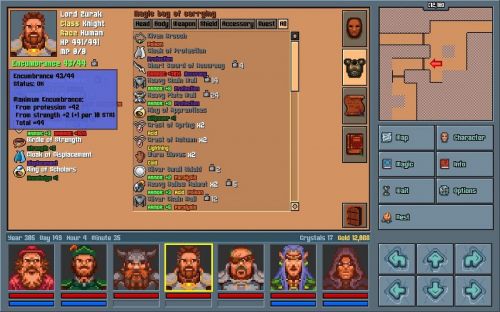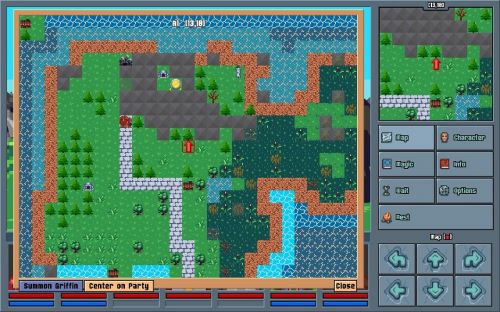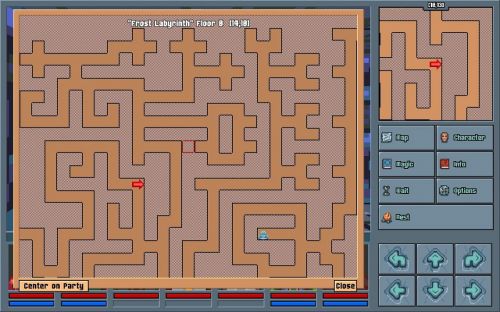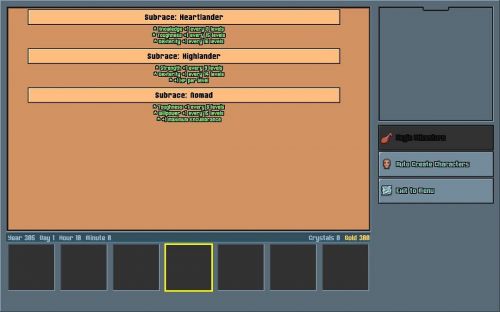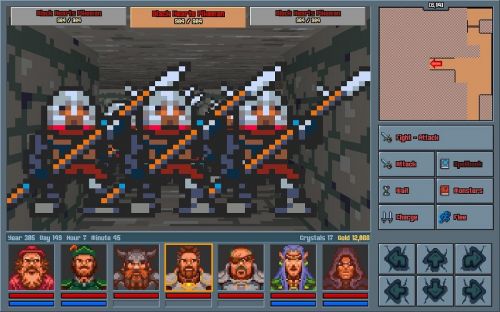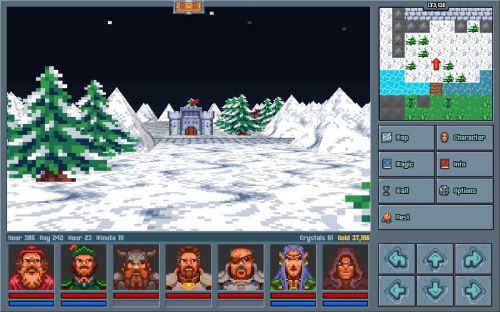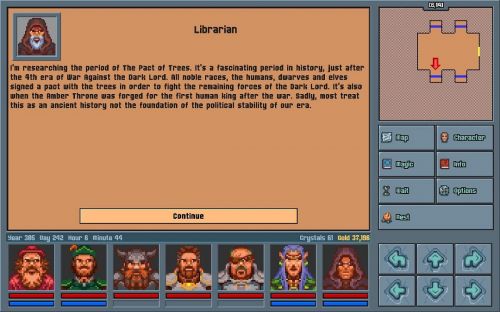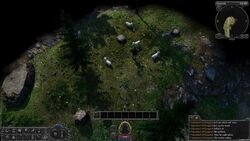RPG Codex Review: Legends of Amberland
RPG Codex Review: Legends of Amberland
Codex Review - posted by Infinitron on Tue 17 September 2019, 00:15:28
Tags: Legends of Amberland: The Forgotten Crown; Silver Lemur Games[Review by Dorateen]
This review is based on a playthrough completed with version 1.12
Legends of Amberland: The Forgotten Crown is a computer roleplaying game inspired primarily by Might & Magic. When making reference to that venerable series of open-world dungeon crawlers, one must draw a distinction between the earlier titles and the later ones. Midway through the franchise, beginning with Might & Magic VI: The Mandate of Heaven in 1998, the series reduced the number of characters in the party while introducing a hybrid real-time combat system alongside traditional turn-based combat. While retaining first person exploration, it switched to allow free movement in a fully realized 3D world (not including Might & Magic X: Legacy, which was more of an experimental throwback).
The original Might & Magic and its four sequels were step-based and played on a grid. Party sizes ranged from six to eight, including hirelings who could be recruited into the party and functioned like normal party members. Conforming to the oldest of old school principles, they initially had no automap, thereby necessitating orientation via hand drawn maps on graph paper. The first two games were considered to have the most hardcore combat of the series, with tactical back and front row formations and restricted saving. It was the Might & Magic III engine that first presented a more inviting approach, boasting bright friendly colors and even cartoonish imagery, producing a more comfortable experience for the player.
That is where The Forgotten Crown fits in, with its seven character party, 100% turn-based combat, and arrangement of tile-based outdoor maps and dungeons. It's a game very much in the style of Might & Magic III through V.
Upon starting a new game, the player will have the customary option of selecting a difficulty level. This is important, as these settings will have a great deal of influence on your perception of Amberland. You're likely to find Normal difficulty setting too easy and more appropriate for a casual run. Making this the default setting was probably a wise choice for introducing a retro roleplaying game like this to modern audiences. On the other hand, the highest difficulty level titled “Insane” went through little balance testing and best serves as a means to challenge players after an initial playthrough. But the Hard difficulty setting, in which monsters inflict more damage, the amount of experience required to train is increased by 20% and the prices in town are doubled, seems just about right. I found this setting to be the perfect match for a veteran of Might & Magic.
EXCEPTIONS
While Legends of Amberland is similar to the Might & Magic games in many ways, there are some familiar features from those games that are missing. For example, when the party first enters the game world, it will not be long before spying some pointy-eared green goblin with a toothy grin bobbing up and down in the distance. A player familiar with the Might & Magic games might have the initial instinct to equip their characters with ranged weapons and fire a few warning shots into the little monster. Except there are no bows. Ranged combat simply does not exist in Legends of Amberland. All fights are settled with melee and magic when the party and monsters step onto the same square on the map.
Another conspicuous absence will be discovered even sooner during the character creation process. There is no Robber or Thief among the classes available to choose from. As a consequence, traps will not be encountered in this adventure. Treasure chests are found unlocked, their contents readily available to the party for looting. (At least the messages when stepping on a chest that has already been emptied can be amusing.) The rogue class has been sidelined before in other computer games, so this is not an unprecedented design decision. But I find it unfortunate nonetheless, because a stealthy character who can launch spectacular attacks such as backstabbing or assassinations (in addition to being useful outside of combat) is part of the roleplaying game heritage.
Finally, another aspect of the Might & Magic series that I miss is towns that can be fully explored. In Legends of Amberland, the various towns are presented as static 2D screens with a list available services. This method is certainly functional and efficient, as the trainer and shops are only a click away. There's a town hall where you can get information from the mayor, a healer who will remedy any character’s afflictions, and an inn which can contain up to three NPCs who might even have their own personal quests. However, with the outdoor locations and dungeons and castles available for exploration, it would have been a welcome addition to be able to wander around these hubs of civilization as well. Interestingly, Amberland’s castles house many of these same services, almost doubling as secondary towns.
SOMETHING NEW
Conversely, there are a few mechanical elements that add a different take to the gameplay formula, rather than being a straight clone of the beloved classics. The most significant to me was the inclusion of an encumbrance system. Legends of Amberland gives weight to armor, weapons, shields and head gear, limiting how much characters can equip. The carrying capacity of each character is determined foremost by class, although different races can get a bonus (or penalty), and the strength attribute influences this value. For example, Knights begin with the highest maximum encumbrance, while elves must cope with a -1 to their encumbrance. Ultimately this means the player will have to do some sorting of items and inventory juggling, especially as new treasures are found. Your Warrior might want to wield that heavy iron hammer, but it has a weight of 12 and equipping it will push the character over the carrying limit. So one option is to swap out a different piece of equipment, such as exchanging a helmet for a mithril helm that is lighter, in order to safely use the weapon. Exceeding a character’s maximum encumbrance will incur a penalty on their fighting and spellcasting effectiveness. The way this is handled is not difficult to grasp, but it does provide the player something to consider as they outfit their party.
The configuration of character statistics is another sphere where the game makes its own imprint. There are five attributes, each having multiple effects on derivative stats. Strength affects physical damage dealt by melee attacks, but also as mentioned, influences encumbrance directly. For every ten points of strength, a character’s encumbrance value will increase by one point. Dexterity affects how often your fighters will hit, and also increases the secondary stat called Evade - that is, the chance of being hit by an enemy. Perhaps most interesting is the Knowledge attribute, which is relevant to all classes. That's because each class has its own Talent. Knights and Warriors have a talent called Tactics which governs their chance of landing critical hits. Investing in Knowledge will increase this percentile. Rangers and Bards have a talent called Awareness, and investing in Knowledge will increase their Evade stat. Finally, Wizards and Healers have a talent called Arcane Bonus that is related to their Knowledge attribute. This in turn creates an interplay between multiple stats when it comes to using magic.
Any class that can cast spells has a pool of Magic Points. This reflects the cost that is attached to each spell. The attribute Will Power influences this number, and the more characters invest in this attribute, the more Magic Points they will get when leveling up. An equally important derived statistic is called Arcane, which again can be increased by Wizards and Healers who invest in Knowledge. Every spell has five levels of Arcane Mastery. The higher the mastery the more effective a spell will be, and in some cases its Magic Points cost will even be reduced. Thus there emerges a dynamic where spellcasting characters can choose to increase either Will Power, which would expand their pool of Magic Points, or Knowledge, thus pumping up their Arcane stat and lowering spell costs upon reaching higher mastery levels.
This is all part of a detailed character system with quite a bit of number crunching going on in the background. The five core attributes automatically increase at intermittent levels of experience. The frequency of attribute increases, as well as which attributes increase, is determined by class and race (including sub-races). Thus, a diverse party comprised of a variety of characters will find leveling up to be a staggered process. Sometimes a character will have the opportunity to spend extra points freely, allowing for further customization. One feature I thought was nice is that when magic users have upcoming new spells, the training screen will preview them the level before. In other words, if a Wizard has new spells available at level 10, then when he advances to 9th level he is shown a list of the spells he will soon be learning. This gives such party members something to look forward to.
Another way to increase the five attributes is through the use of color-coded vials which must be delivered to town healers. These allow characters to boost the corresponding attribute by one point. It's reminiscent of the stat-boosting barrels found in classic Might & Magic adventures, where red liquid equals might and so on. Often these precious vials serve as a reward from NPCs emancipated or otherwise assisted by the party. Finally, I would like to mention Amberland’s use of crystals. Rather than serving as a component for spell casting like gems, the crystals found here are a currency to be spent in magic shops that offer unique enchanted items different from what is available in standard shops.
OVERWORLD EXPLORATION
It is here that The Forgotten Crown excels. The world of Amberland is represented as an oblong map, with six latitudinal zones labeled A through F, and five zones running north to south numbered 1 to 5. Most of these areas are explorable 20 x 20 square maps. It's a fairly large world that includes all the favorite Might & Magic biomes: from temperate regions to swamps, arctic zones and volcanic fields with heat damaging tiles, and of course a brutal sprawling desert. There are also numerous waterways to be navigated, thus evoking the island hopping infrastructure of Isles of Terra. Exploration is aided by the presence of a minimap in the top right corner of the screen, which has a setting in the configuration menu to display fog over tiles not yet explored.
The adventure begins in the northwest-most quadrant of the map. By clicking on the Info button of the user interface, the player will learn this area is part of the Western Territories, and will be treated to a paragraph length dose of lore and background about the region. This type of information is available for every map, including dungeons and castles. Sometimes the details are sparse, a few words describing the current location. In other places, a good deal of flavor has been provided to help paint a colorful land for discovery and inspire one’s imagination.
The opening screen presents the party with a message from the Royal Wizard, who has summoned the heroes to tell them of a mystery that confounds the Kingdom. While this innocuous letter might nudge the player in the direction of the Royal Castle, there is no immediacy that forces them to go there. This is the defining characteristic of the game: the player is never chained to a specific narrative or course of action, the party is entirely free to explore content in whatever order they wish. There might be some areas with higher level enemies that can temporarily impede your progress. But these are met as challenges for a resourceful party to overcome. There are naturally occurring bodies of water the must eventually be crossed, and it's up to the player to find solutions to these obstacles within their own means and limitations. To underscore the point of non-linearity, my party visited several locations and turned in other quests, before ever delivering that letter to the Royal Wizard.
Gallivanting across the countryside, Amberland will reveal numerous points of interest waiting to be discovered. I counted more than three dozen hostile dungeons, such as caverns and abandoned mines, fortified keeps and sorcerous towers. In addition, there are a handful of different towns and a half dozen friendly castles, although some contain lower levels with unfriendly occupants. Clearing the outdoor maps can uncover magic fountains or cabins in which reside a wide range of NPCs, some who require your help and some who can help you. In fact, a third way of increasing your attributes is by finding special teachers devoted to each attribute as a discipline, who will increase that attribute by one point.
Two types of watery passages exist. One is shallow and represented by light blue tiles. A simple boat is sufficient to navigate these currents. The second type is dark blue and represents the open seas. A more sturdy ship is required before the party can traverse these deeper waters. Both types of craft, boat and ship, can be either purchased or obtained through the fulfillment of quests. Doing so is the key to accessing new areas, further expanding the map.
Legends of Amberland also features a method of fast travel, in the form of a griffin that can be summoned and will fly the party to any coordinate on the map that has already been visited. However, this aerial transport is not immediately available. In satisfying fashion, it is a reward for characters once they have completed a daring deed. As a means of cutting down on the enormous amount of backtracking this design is consistent with the Might & Magic series, which included beacon spells and portals.
The objective of all this exploration is the fulfillment of quests. These are varied, ranging from clearing out monster lairs to retrieving rare items to the more esoteric “learn the secret to enter the Enchanted Forest”. In fact, many quests have multiple stages and are intricate enough to keep the player guessing. The most clever missions have the party returning to previously acquainted NPCs or locations, drawing upon gathered information and depending on the player to make connections. An in-game quest journal keeps track of quests in progress as well as those completed. And a nifty section of the character screen displays titles and notable exploits acquired by the party over the course of the adventure.
DUNGEONS
Legends of Amberland is never going to win any awards for dungeon design. Whether delving into keeps or caverns, there are no secret doors, no word puzzles, no teleportation traps, spinners or dark zones. Sometimes locked gates will block the party. The activation levers may be nearby or on the other side, which requires a bit of searching. Towers usually have multiple levels, and sometimes barriers are present that will inflict elemental damage unless mitigated by characters with proper protections.
That's not to say that the dungeons in Amberland lack variety in shape and appearance. Different tints of wall textures are used to create atmospheric or thematic resonance: icy blue in the northern snow lands, murky green with veins of red in a nest of spiders, or tawny brown stone in a fort overrun with ogres. Some of them are small in size with only a few rooms. But some of the more ambition designs can stretch far enough that the full screen automap might scroll in every direction. One particular labyrinth reaches maze-like quality with its twisting passages.
Unlike the complex dungeons of Wizardry-style crawlers that are themselves opponents for the party to master, the purpose of dungeons in Amberland is more straightforward. Clear out the monsters and take their treasure. But there is always at least one surprise to be unearthed. This might be a long sought after quest item, a prisoner in need of rescuing, or some other NPC who will grant a boon to the heroes. One creative feature found in the game is the concept of master craftsmen who have been kidnapped and stashed away in dungeons throughout the land. Finding and liberating these hapless merchants will result in higher quality items appearing at the shops back in town.
If one subscribes to the characterization of tile-based outdoor levels as a “dungeon with a skybox”, then the overworld as described above is a fantastic example. I would have liked to see the same approach to design in the game's interior areas, with more obstacles that the player must figure out how to bypass, inventory items that are required to unlock rooms, and of course, hidden passages and traps. As it stands, the wide world of Amberland is the main focus of the game, dotted with locations that remain a side attraction.
CHARACTER CREATION
Assembling a party of heroes in an old school roleplaying game is always a rewarding experience. Legends of Amberland includes a quick-start option, which will push the player out the door with a group of auto-generated characters. But where's the enjoyment in that? You have the opportunity to create and fill a robust seven spots with an assortment of class and race combinations.
The races of Amberland are divided into sub-races, each with its own gameplay bonuses such as the rate at which particular attributes increase or immunities to particular status effects. For example, if a player chooses a human character, they can be either a Nomad, a Highlander, or a Heartlander. Since I had three humans in my party, I was able to take one of each. There are four types of dwarves and three sub-races of elves. An interesting aspect of selecting a half-elf is that the player can choose whether the dominant heritage is from the human side or the elven side. Again, each one will impart different advantages. All told, there are twelve potential races for customizing a character.
After selecting the character's race, the player will be presented with a list of available classes. There are six base classes, but each race unlocks two more that are hybrids or variants. For example, a human could also be a Champion, which is derived from the Knight class or a Troubadour that is a type of Bard. These “racial classes” often come with trade-offs and it will be up to the player to decide their value. In the case of the Champion class, the character receives a lower carrying capacity but will do extra damage against sorcerers. There are numerous occasions when the party will cross paths with these dastardly spellcasters, so it's a matter of deciding if the encumbrance penalty is worth the situational damage boost. Similarly, I decided to go with a dwarven Troll Slayer (a variant of the Warrior), but at the cost of giving up on a shield and accessory equipment slot. As the name implies, this was in return for dealing greater damage to the various trolls encountered in Amberland. The class also receives a bonus to encumbrance as well as additional hit points per level. When factoring in the two additional classes that each race unlocks, there are a total of twelve classes obtainable through character creation. Since the racial classes are usually hybrids and introduce balance restrictions, they can serve as a way for players to tailor a more challenging experience for themselves by using them instead of the base classes.
Another detail that rounds out the character sheet is the appearance of damage resistances and immunities to status effects. The resistances are elemental in nature, offering greater protection from damage types such as fire, cold, acid and lightning. The status immunities relate to negative effects such as paralysis, confusion and petrification among others. A blanket immunity will protect a character from an effect entirely - in other words it is a hard counter against certain enemy attacks. Some sub-races include automatic resistances or immunities, so this is an additional consideration when building your party. All of these defensive measures can also be acquired by equipping appropriate items.
COMBAT
Battle is joined when the party steps on a tile occupied by an enemy, or in some instances when the enemy jumps into the party's face. While exploring, monsters and men alike are not stationary but move around in their own radius. This creates a situation where an adventuring party can decide each turn whether to advance, retreat or wait while the enemy reposition themselves like pieces on a game board. Sometimes monsters seek to block or restrict the player’s mobility. When both sides finally clash, they are locked in a life and death struggle until one side emerges victorious. And once vanquished, enemies are gone forever as maps do not repopulate.
There's a non-transparent initiative value which determines who gets to act first. Enemies who come in early are typically quick foes who will sneak in a hit before you can react. As for the heroes, the order that each character goes is determined by their position in the party. In a row of seven, it is the central spot that is considered Position One. This character will always be the first party member to take an action, and is also on the receiving end of most incoming attacks. Flanked on either side by characters in Position Two and Three, these act in sequence respectively and they are also treated as part of the front line. The formation ranks continue so that back row support characters are the ones on the far left and far right, who will always act last. It is a system that leverages initiative versus relative security from being targeted. However, once more dangerous enemies who have area-of-effect attacks show up, no party member is completely safe.
Opponents arrange themselves in rows of up to three at a time. Due to their mobile nature, it's likely that others in an area will join a battle in progress once a spot opens up. For example, imagine a large room filled with monsters, moving closer as they engage the party. The player might start out facing two or three of them, but could end up taking on a half dozen or more before gaining any respite. Another tactic enemies use is to crowd inside doorways. Thus, before successfully entering a chamber the party is forced to cut through what seems like an endless horde, which can make for some tense pitched battles.
Every class in Legends of Amberland has a Special Ability that a character of that class can use in addition to their standard attack. The Knight and its variants have a Charge attack that can hit all three enemies on screen. Warriors get a powerful Strike attack that is used to inflict greater damage to a single opponent. Bards can play a song that will replenish a percentage of Spell Points and Hit Points for all party members, while Healers have a lifesaving Recovery ability that will restore all characters who have fallen in battle. The catch is that these Special Abilities can only be activated once before requiring a rest. This becomes a strategic consideration for the player, who has to pick the right moment to use them and ensure that his characters have recharged before facing particularly deadly adversaries.
Resources are vital in a game with frequent combat. Heroes will lose hit points, expend their magic and trigger single use abilities. Thus it becomes necessary to rest, which in turn like in any good Might & Magic-type adventure requires food. There are two forms of nourishment that can be restocked in towns, with two corresponding modes of resting. A full rest is eight hours long and revives the party completely at the cost of both one vegetable ration and one meat ration. Then there's the quick rest, only four hours long, which uses up just one vegetable ration. The quick rest does not restore spell points and only restores half of the party's hit points, but it does reset Special Abilities and cure certain status effects. Therefore it can be used more strategically to save on resources.
Spells can sorted into three general categories. There's offensive magic, healing and curative magic, and preventative or enhancement magic. The latter takes the form of party-wide buffs, including spells like Regeneration, Inspiration (for extra strength), and Magic Armor. These spells do not have a fixed duration. Instead, all buffs expire at midnight on a twenty-four hour clock. It sets a pattern of casting your protections early in the day to take advantage of having them up as long as possible. Later in the game, I often had as many as seven effects running at the same time. (A single mass buff spell would have been a welcome addition.) As mentioned previously, all spells have mastery levels ranked from one to five which increase their power and efficiency. However, with direct damage spells being fairly limited, it seems spellcasters are more suitable as support characters for the fighters who deliver the majority of destruction.
Playing Legends of Amberland on Hard difficulty, my party regularly squared off against enemies who outclassed them by having more hit points, hitting harder and causing all sorts of calamities. The game's open world quality means players can pick and choose their battles, venturing briefly into zones that are over their head and coming back later to squash the monsters who gave them so much trouble. There are encounters that can decimate an underleveled party, and it's very gratifying to defeat them as you acquire power and develop new tactics.
When an enemy is defeated, the party will gain experience and gold, and sometimes items from specific villains. All the other treasure in the game is found in chests. It is at this point that I want to mention the itemization in Amberland. The variety of available equipment in the game is merely serviceable. To be clear, it's not exactly bad. There are armors that offer myriad protections, shields that boost damage, weapons with effects like whirling (hit all enemies) or slayer (increased critical hit chance), and lots of helpful accessories that can add resistances or modify attributes. The problem, I think, is that the game is large enough (the character level range reaches past fifty) to have supported a much more varied set of equipment. Before long the party will find itself picking up the same items over and over again. I lost count of how many enchanted elven blades I found. The most unique equipment in the game is available for purchase once you unlock the master craftsmen and at the towns' magic shops. I must say that the economy felt decently balanced because there were multiple such upper tier items selling for 40,000+ gold which I had to save up for. This left me with the impression that the excess loot picked up in dungeons was really only there for selling to raise funds to buy better stuff from merchants.
Otherwise, the game's pacing is excellent. Characters advance briskly - you're never confronted with a gulf of hundreds of thousands of experience points before you gain a level. Completing a dungeon almost always ensures the entire party can visit the trainer. There are also hefty experience awards for turning in quests. Since character level is the driving force in becoming more powerful, you will notice improvements very quickly. Every couple of levels, different party members will see their attributes increase or receive attribute points to distribute. There's always some new destination on the horizon, something else to do or new monsters to fight, leaving the player to wonder what awaits beyond the next bridge.
ART AND MUSIC
Visually, Legends of Amberland uses pixelated graphics, which should be immediately apparent right from the opening splash screen. As someone who appreciates that style, I found the the portraits of the player characters and the NPCs in text boxes very well done. The outdoor terrain can be picturesque at times, with snow-covered pine trees along the approach to a majestic castle. Puffs of smoke rise from wooden cabins as well as lava-crowned volcanos. However, when it comes to the monsters and other enemies who populate the game world, the over-pixelation begins to detract. Blocky and not very lovely, the sprites at least do a reasonably good job at distinguishing different enemy types. Snakes bare fangs, spiders flail their legs, and all manner of hostile individuals clutch their weapons fiercely. It is something of an acquired taste, and once immersed, the player will grow accustomed and might even discover some charm in this art direction.
Aside from a few wrinkles and creases around the movement arrow buttons, the user interface is not very stylized. The rest of the screen lends a pedestrian quality to the game’s presentation, which might lead to a false impression of simplistic design. In fact, the user interface is extremely context sensitive with lots of information available via mouse over. The character and inventory screens in particular communicate to the player almost every aspect of the ruleset using this method. Furthermore, you can press the Info button during combat to pull up a display that shows the currently highlighted enemy’s statistics. The layout is clean and intuitive with an inoffensive, legible font.
Amberland's soundtrack is composed competently and appropriately for the tenor of this adventure. The synthesized tintinnabulation of the overworld track helps weave a dream-like experience. Other tracks range from sweeping progressions inside castles or important places to the savage percussive beat heard in the lairs of trolls. The sound effects are what you'd expect from a computer roleplaying game: the slicing sound of a character being hit, a monster’s dying grunts, and the chimes announcing different awards.
Finally, The Forgotten Crown's writing is light-hearted and humorous, echoing the tone of the titles that inspired the game. There are NPCs who are self-aware or cynical, even barking at the characters not to keep bothering them. Yet digging deeper, it's evident that the game has plenty of backstory, an undercurrent of history that contributes to a vibrant fantasy world. Nobles and common folk will share their thoughts on events past and present. The bits of lore you come across (which is never intrusive) spin a fairy tale about Amberland. It all comes together to forge the story of a heroic quest, the stuff of legends.
CONCLUSIONS
There's an expression that says, pretty is as pretty does. It means superficial outward appearances are not the measure of something’s worth, and it's what it accomplishes that counts. Legends of Amberland is a computer roleplaying game that does what it sets out to do. Obviously the game will appeal especially to fans of the third through fifth installments of Might & Magic. While in some areas Legends of Amberland falls short of those masterpieces crafted by Jon Van Caneghem more than twenty five years ago, in other places Silver Lemur’s effort shows flashes of brilliance.
For an independent production, the scope of the game world is admirable. Exploration and character development is addictive. At the higher difficulty levels, a completionist playthrough would probably take about thirty hours on a first try.
From a technical perspective, the game is solid. I did not experience any game-breaking bugs. It performs smoothly and the interface makes it possible for a new player to jump right in. Of course I would always recommend the established classics to someone willing to explore the roots of the genre in the early 1990s, but there is a case to be made that we now have a new alternative for introducing dungeon crawlers to beginners.
Amberland's unbridled potential offers room for improvement in future adventures by constructing more devious dungeons and improving itemization, should the game's developer decide to go in that direction. I was certainly left wanting to know more about Amberland and perhaps have a hand in determining its fate.
In its final form, The Forgotten Crown serves as a memorable homage to tradition and old school design.
This review is based on a playthrough completed with version 1.12
Legends of Amberland: The Forgotten Crown is a computer roleplaying game inspired primarily by Might & Magic. When making reference to that venerable series of open-world dungeon crawlers, one must draw a distinction between the earlier titles and the later ones. Midway through the franchise, beginning with Might & Magic VI: The Mandate of Heaven in 1998, the series reduced the number of characters in the party while introducing a hybrid real-time combat system alongside traditional turn-based combat. While retaining first person exploration, it switched to allow free movement in a fully realized 3D world (not including Might & Magic X: Legacy, which was more of an experimental throwback).
The original Might & Magic and its four sequels were step-based and played on a grid. Party sizes ranged from six to eight, including hirelings who could be recruited into the party and functioned like normal party members. Conforming to the oldest of old school principles, they initially had no automap, thereby necessitating orientation via hand drawn maps on graph paper. The first two games were considered to have the most hardcore combat of the series, with tactical back and front row formations and restricted saving. It was the Might & Magic III engine that first presented a more inviting approach, boasting bright friendly colors and even cartoonish imagery, producing a more comfortable experience for the player.
That is where The Forgotten Crown fits in, with its seven character party, 100% turn-based combat, and arrangement of tile-based outdoor maps and dungeons. It's a game very much in the style of Might & Magic III through V.
Upon starting a new game, the player will have the customary option of selecting a difficulty level. This is important, as these settings will have a great deal of influence on your perception of Amberland. You're likely to find Normal difficulty setting too easy and more appropriate for a casual run. Making this the default setting was probably a wise choice for introducing a retro roleplaying game like this to modern audiences. On the other hand, the highest difficulty level titled “Insane” went through little balance testing and best serves as a means to challenge players after an initial playthrough. But the Hard difficulty setting, in which monsters inflict more damage, the amount of experience required to train is increased by 20% and the prices in town are doubled, seems just about right. I found this setting to be the perfect match for a veteran of Might & Magic.
EXCEPTIONS
While Legends of Amberland is similar to the Might & Magic games in many ways, there are some familiar features from those games that are missing. For example, when the party first enters the game world, it will not be long before spying some pointy-eared green goblin with a toothy grin bobbing up and down in the distance. A player familiar with the Might & Magic games might have the initial instinct to equip their characters with ranged weapons and fire a few warning shots into the little monster. Except there are no bows. Ranged combat simply does not exist in Legends of Amberland. All fights are settled with melee and magic when the party and monsters step onto the same square on the map.
Another conspicuous absence will be discovered even sooner during the character creation process. There is no Robber or Thief among the classes available to choose from. As a consequence, traps will not be encountered in this adventure. Treasure chests are found unlocked, their contents readily available to the party for looting. (At least the messages when stepping on a chest that has already been emptied can be amusing.) The rogue class has been sidelined before in other computer games, so this is not an unprecedented design decision. But I find it unfortunate nonetheless, because a stealthy character who can launch spectacular attacks such as backstabbing or assassinations (in addition to being useful outside of combat) is part of the roleplaying game heritage.
Finally, another aspect of the Might & Magic series that I miss is towns that can be fully explored. In Legends of Amberland, the various towns are presented as static 2D screens with a list available services. This method is certainly functional and efficient, as the trainer and shops are only a click away. There's a town hall where you can get information from the mayor, a healer who will remedy any character’s afflictions, and an inn which can contain up to three NPCs who might even have their own personal quests. However, with the outdoor locations and dungeons and castles available for exploration, it would have been a welcome addition to be able to wander around these hubs of civilization as well. Interestingly, Amberland’s castles house many of these same services, almost doubling as secondary towns.
SOMETHING NEW
Conversely, there are a few mechanical elements that add a different take to the gameplay formula, rather than being a straight clone of the beloved classics. The most significant to me was the inclusion of an encumbrance system. Legends of Amberland gives weight to armor, weapons, shields and head gear, limiting how much characters can equip. The carrying capacity of each character is determined foremost by class, although different races can get a bonus (or penalty), and the strength attribute influences this value. For example, Knights begin with the highest maximum encumbrance, while elves must cope with a -1 to their encumbrance. Ultimately this means the player will have to do some sorting of items and inventory juggling, especially as new treasures are found. Your Warrior might want to wield that heavy iron hammer, but it has a weight of 12 and equipping it will push the character over the carrying limit. So one option is to swap out a different piece of equipment, such as exchanging a helmet for a mithril helm that is lighter, in order to safely use the weapon. Exceeding a character’s maximum encumbrance will incur a penalty on their fighting and spellcasting effectiveness. The way this is handled is not difficult to grasp, but it does provide the player something to consider as they outfit their party.
The configuration of character statistics is another sphere where the game makes its own imprint. There are five attributes, each having multiple effects on derivative stats. Strength affects physical damage dealt by melee attacks, but also as mentioned, influences encumbrance directly. For every ten points of strength, a character’s encumbrance value will increase by one point. Dexterity affects how often your fighters will hit, and also increases the secondary stat called Evade - that is, the chance of being hit by an enemy. Perhaps most interesting is the Knowledge attribute, which is relevant to all classes. That's because each class has its own Talent. Knights and Warriors have a talent called Tactics which governs their chance of landing critical hits. Investing in Knowledge will increase this percentile. Rangers and Bards have a talent called Awareness, and investing in Knowledge will increase their Evade stat. Finally, Wizards and Healers have a talent called Arcane Bonus that is related to their Knowledge attribute. This in turn creates an interplay between multiple stats when it comes to using magic.
Any class that can cast spells has a pool of Magic Points. This reflects the cost that is attached to each spell. The attribute Will Power influences this number, and the more characters invest in this attribute, the more Magic Points they will get when leveling up. An equally important derived statistic is called Arcane, which again can be increased by Wizards and Healers who invest in Knowledge. Every spell has five levels of Arcane Mastery. The higher the mastery the more effective a spell will be, and in some cases its Magic Points cost will even be reduced. Thus there emerges a dynamic where spellcasting characters can choose to increase either Will Power, which would expand their pool of Magic Points, or Knowledge, thus pumping up their Arcane stat and lowering spell costs upon reaching higher mastery levels.
This is all part of a detailed character system with quite a bit of number crunching going on in the background. The five core attributes automatically increase at intermittent levels of experience. The frequency of attribute increases, as well as which attributes increase, is determined by class and race (including sub-races). Thus, a diverse party comprised of a variety of characters will find leveling up to be a staggered process. Sometimes a character will have the opportunity to spend extra points freely, allowing for further customization. One feature I thought was nice is that when magic users have upcoming new spells, the training screen will preview them the level before. In other words, if a Wizard has new spells available at level 10, then when he advances to 9th level he is shown a list of the spells he will soon be learning. This gives such party members something to look forward to.
Another way to increase the five attributes is through the use of color-coded vials which must be delivered to town healers. These allow characters to boost the corresponding attribute by one point. It's reminiscent of the stat-boosting barrels found in classic Might & Magic adventures, where red liquid equals might and so on. Often these precious vials serve as a reward from NPCs emancipated or otherwise assisted by the party. Finally, I would like to mention Amberland’s use of crystals. Rather than serving as a component for spell casting like gems, the crystals found here are a currency to be spent in magic shops that offer unique enchanted items different from what is available in standard shops.
OVERWORLD EXPLORATION
It is here that The Forgotten Crown excels. The world of Amberland is represented as an oblong map, with six latitudinal zones labeled A through F, and five zones running north to south numbered 1 to 5. Most of these areas are explorable 20 x 20 square maps. It's a fairly large world that includes all the favorite Might & Magic biomes: from temperate regions to swamps, arctic zones and volcanic fields with heat damaging tiles, and of course a brutal sprawling desert. There are also numerous waterways to be navigated, thus evoking the island hopping infrastructure of Isles of Terra. Exploration is aided by the presence of a minimap in the top right corner of the screen, which has a setting in the configuration menu to display fog over tiles not yet explored.
The adventure begins in the northwest-most quadrant of the map. By clicking on the Info button of the user interface, the player will learn this area is part of the Western Territories, and will be treated to a paragraph length dose of lore and background about the region. This type of information is available for every map, including dungeons and castles. Sometimes the details are sparse, a few words describing the current location. In other places, a good deal of flavor has been provided to help paint a colorful land for discovery and inspire one’s imagination.
The opening screen presents the party with a message from the Royal Wizard, who has summoned the heroes to tell them of a mystery that confounds the Kingdom. While this innocuous letter might nudge the player in the direction of the Royal Castle, there is no immediacy that forces them to go there. This is the defining characteristic of the game: the player is never chained to a specific narrative or course of action, the party is entirely free to explore content in whatever order they wish. There might be some areas with higher level enemies that can temporarily impede your progress. But these are met as challenges for a resourceful party to overcome. There are naturally occurring bodies of water the must eventually be crossed, and it's up to the player to find solutions to these obstacles within their own means and limitations. To underscore the point of non-linearity, my party visited several locations and turned in other quests, before ever delivering that letter to the Royal Wizard.
Gallivanting across the countryside, Amberland will reveal numerous points of interest waiting to be discovered. I counted more than three dozen hostile dungeons, such as caverns and abandoned mines, fortified keeps and sorcerous towers. In addition, there are a handful of different towns and a half dozen friendly castles, although some contain lower levels with unfriendly occupants. Clearing the outdoor maps can uncover magic fountains or cabins in which reside a wide range of NPCs, some who require your help and some who can help you. In fact, a third way of increasing your attributes is by finding special teachers devoted to each attribute as a discipline, who will increase that attribute by one point.
Two types of watery passages exist. One is shallow and represented by light blue tiles. A simple boat is sufficient to navigate these currents. The second type is dark blue and represents the open seas. A more sturdy ship is required before the party can traverse these deeper waters. Both types of craft, boat and ship, can be either purchased or obtained through the fulfillment of quests. Doing so is the key to accessing new areas, further expanding the map.
Legends of Amberland also features a method of fast travel, in the form of a griffin that can be summoned and will fly the party to any coordinate on the map that has already been visited. However, this aerial transport is not immediately available. In satisfying fashion, it is a reward for characters once they have completed a daring deed. As a means of cutting down on the enormous amount of backtracking this design is consistent with the Might & Magic series, which included beacon spells and portals.
The objective of all this exploration is the fulfillment of quests. These are varied, ranging from clearing out monster lairs to retrieving rare items to the more esoteric “learn the secret to enter the Enchanted Forest”. In fact, many quests have multiple stages and are intricate enough to keep the player guessing. The most clever missions have the party returning to previously acquainted NPCs or locations, drawing upon gathered information and depending on the player to make connections. An in-game quest journal keeps track of quests in progress as well as those completed. And a nifty section of the character screen displays titles and notable exploits acquired by the party over the course of the adventure.
DUNGEONS
Legends of Amberland is never going to win any awards for dungeon design. Whether delving into keeps or caverns, there are no secret doors, no word puzzles, no teleportation traps, spinners or dark zones. Sometimes locked gates will block the party. The activation levers may be nearby or on the other side, which requires a bit of searching. Towers usually have multiple levels, and sometimes barriers are present that will inflict elemental damage unless mitigated by characters with proper protections.
That's not to say that the dungeons in Amberland lack variety in shape and appearance. Different tints of wall textures are used to create atmospheric or thematic resonance: icy blue in the northern snow lands, murky green with veins of red in a nest of spiders, or tawny brown stone in a fort overrun with ogres. Some of them are small in size with only a few rooms. But some of the more ambition designs can stretch far enough that the full screen automap might scroll in every direction. One particular labyrinth reaches maze-like quality with its twisting passages.
Unlike the complex dungeons of Wizardry-style crawlers that are themselves opponents for the party to master, the purpose of dungeons in Amberland is more straightforward. Clear out the monsters and take their treasure. But there is always at least one surprise to be unearthed. This might be a long sought after quest item, a prisoner in need of rescuing, or some other NPC who will grant a boon to the heroes. One creative feature found in the game is the concept of master craftsmen who have been kidnapped and stashed away in dungeons throughout the land. Finding and liberating these hapless merchants will result in higher quality items appearing at the shops back in town.
If one subscribes to the characterization of tile-based outdoor levels as a “dungeon with a skybox”, then the overworld as described above is a fantastic example. I would have liked to see the same approach to design in the game's interior areas, with more obstacles that the player must figure out how to bypass, inventory items that are required to unlock rooms, and of course, hidden passages and traps. As it stands, the wide world of Amberland is the main focus of the game, dotted with locations that remain a side attraction.
CHARACTER CREATION
Assembling a party of heroes in an old school roleplaying game is always a rewarding experience. Legends of Amberland includes a quick-start option, which will push the player out the door with a group of auto-generated characters. But where's the enjoyment in that? You have the opportunity to create and fill a robust seven spots with an assortment of class and race combinations.
The races of Amberland are divided into sub-races, each with its own gameplay bonuses such as the rate at which particular attributes increase or immunities to particular status effects. For example, if a player chooses a human character, they can be either a Nomad, a Highlander, or a Heartlander. Since I had three humans in my party, I was able to take one of each. There are four types of dwarves and three sub-races of elves. An interesting aspect of selecting a half-elf is that the player can choose whether the dominant heritage is from the human side or the elven side. Again, each one will impart different advantages. All told, there are twelve potential races for customizing a character.
After selecting the character's race, the player will be presented with a list of available classes. There are six base classes, but each race unlocks two more that are hybrids or variants. For example, a human could also be a Champion, which is derived from the Knight class or a Troubadour that is a type of Bard. These “racial classes” often come with trade-offs and it will be up to the player to decide their value. In the case of the Champion class, the character receives a lower carrying capacity but will do extra damage against sorcerers. There are numerous occasions when the party will cross paths with these dastardly spellcasters, so it's a matter of deciding if the encumbrance penalty is worth the situational damage boost. Similarly, I decided to go with a dwarven Troll Slayer (a variant of the Warrior), but at the cost of giving up on a shield and accessory equipment slot. As the name implies, this was in return for dealing greater damage to the various trolls encountered in Amberland. The class also receives a bonus to encumbrance as well as additional hit points per level. When factoring in the two additional classes that each race unlocks, there are a total of twelve classes obtainable through character creation. Since the racial classes are usually hybrids and introduce balance restrictions, they can serve as a way for players to tailor a more challenging experience for themselves by using them instead of the base classes.
Another detail that rounds out the character sheet is the appearance of damage resistances and immunities to status effects. The resistances are elemental in nature, offering greater protection from damage types such as fire, cold, acid and lightning. The status immunities relate to negative effects such as paralysis, confusion and petrification among others. A blanket immunity will protect a character from an effect entirely - in other words it is a hard counter against certain enemy attacks. Some sub-races include automatic resistances or immunities, so this is an additional consideration when building your party. All of these defensive measures can also be acquired by equipping appropriate items.
COMBAT
Battle is joined when the party steps on a tile occupied by an enemy, or in some instances when the enemy jumps into the party's face. While exploring, monsters and men alike are not stationary but move around in their own radius. This creates a situation where an adventuring party can decide each turn whether to advance, retreat or wait while the enemy reposition themselves like pieces on a game board. Sometimes monsters seek to block or restrict the player’s mobility. When both sides finally clash, they are locked in a life and death struggle until one side emerges victorious. And once vanquished, enemies are gone forever as maps do not repopulate.
There's a non-transparent initiative value which determines who gets to act first. Enemies who come in early are typically quick foes who will sneak in a hit before you can react. As for the heroes, the order that each character goes is determined by their position in the party. In a row of seven, it is the central spot that is considered Position One. This character will always be the first party member to take an action, and is also on the receiving end of most incoming attacks. Flanked on either side by characters in Position Two and Three, these act in sequence respectively and they are also treated as part of the front line. The formation ranks continue so that back row support characters are the ones on the far left and far right, who will always act last. It is a system that leverages initiative versus relative security from being targeted. However, once more dangerous enemies who have area-of-effect attacks show up, no party member is completely safe.
Opponents arrange themselves in rows of up to three at a time. Due to their mobile nature, it's likely that others in an area will join a battle in progress once a spot opens up. For example, imagine a large room filled with monsters, moving closer as they engage the party. The player might start out facing two or three of them, but could end up taking on a half dozen or more before gaining any respite. Another tactic enemies use is to crowd inside doorways. Thus, before successfully entering a chamber the party is forced to cut through what seems like an endless horde, which can make for some tense pitched battles.
Every class in Legends of Amberland has a Special Ability that a character of that class can use in addition to their standard attack. The Knight and its variants have a Charge attack that can hit all three enemies on screen. Warriors get a powerful Strike attack that is used to inflict greater damage to a single opponent. Bards can play a song that will replenish a percentage of Spell Points and Hit Points for all party members, while Healers have a lifesaving Recovery ability that will restore all characters who have fallen in battle. The catch is that these Special Abilities can only be activated once before requiring a rest. This becomes a strategic consideration for the player, who has to pick the right moment to use them and ensure that his characters have recharged before facing particularly deadly adversaries.
Resources are vital in a game with frequent combat. Heroes will lose hit points, expend their magic and trigger single use abilities. Thus it becomes necessary to rest, which in turn like in any good Might & Magic-type adventure requires food. There are two forms of nourishment that can be restocked in towns, with two corresponding modes of resting. A full rest is eight hours long and revives the party completely at the cost of both one vegetable ration and one meat ration. Then there's the quick rest, only four hours long, which uses up just one vegetable ration. The quick rest does not restore spell points and only restores half of the party's hit points, but it does reset Special Abilities and cure certain status effects. Therefore it can be used more strategically to save on resources.
Spells can sorted into three general categories. There's offensive magic, healing and curative magic, and preventative or enhancement magic. The latter takes the form of party-wide buffs, including spells like Regeneration, Inspiration (for extra strength), and Magic Armor. These spells do not have a fixed duration. Instead, all buffs expire at midnight on a twenty-four hour clock. It sets a pattern of casting your protections early in the day to take advantage of having them up as long as possible. Later in the game, I often had as many as seven effects running at the same time. (A single mass buff spell would have been a welcome addition.) As mentioned previously, all spells have mastery levels ranked from one to five which increase their power and efficiency. However, with direct damage spells being fairly limited, it seems spellcasters are more suitable as support characters for the fighters who deliver the majority of destruction.
Playing Legends of Amberland on Hard difficulty, my party regularly squared off against enemies who outclassed them by having more hit points, hitting harder and causing all sorts of calamities. The game's open world quality means players can pick and choose their battles, venturing briefly into zones that are over their head and coming back later to squash the monsters who gave them so much trouble. There are encounters that can decimate an underleveled party, and it's very gratifying to defeat them as you acquire power and develop new tactics.
When an enemy is defeated, the party will gain experience and gold, and sometimes items from specific villains. All the other treasure in the game is found in chests. It is at this point that I want to mention the itemization in Amberland. The variety of available equipment in the game is merely serviceable. To be clear, it's not exactly bad. There are armors that offer myriad protections, shields that boost damage, weapons with effects like whirling (hit all enemies) or slayer (increased critical hit chance), and lots of helpful accessories that can add resistances or modify attributes. The problem, I think, is that the game is large enough (the character level range reaches past fifty) to have supported a much more varied set of equipment. Before long the party will find itself picking up the same items over and over again. I lost count of how many enchanted elven blades I found. The most unique equipment in the game is available for purchase once you unlock the master craftsmen and at the towns' magic shops. I must say that the economy felt decently balanced because there were multiple such upper tier items selling for 40,000+ gold which I had to save up for. This left me with the impression that the excess loot picked up in dungeons was really only there for selling to raise funds to buy better stuff from merchants.
Otherwise, the game's pacing is excellent. Characters advance briskly - you're never confronted with a gulf of hundreds of thousands of experience points before you gain a level. Completing a dungeon almost always ensures the entire party can visit the trainer. There are also hefty experience awards for turning in quests. Since character level is the driving force in becoming more powerful, you will notice improvements very quickly. Every couple of levels, different party members will see their attributes increase or receive attribute points to distribute. There's always some new destination on the horizon, something else to do or new monsters to fight, leaving the player to wonder what awaits beyond the next bridge.
ART AND MUSIC
Visually, Legends of Amberland uses pixelated graphics, which should be immediately apparent right from the opening splash screen. As someone who appreciates that style, I found the the portraits of the player characters and the NPCs in text boxes very well done. The outdoor terrain can be picturesque at times, with snow-covered pine trees along the approach to a majestic castle. Puffs of smoke rise from wooden cabins as well as lava-crowned volcanos. However, when it comes to the monsters and other enemies who populate the game world, the over-pixelation begins to detract. Blocky and not very lovely, the sprites at least do a reasonably good job at distinguishing different enemy types. Snakes bare fangs, spiders flail their legs, and all manner of hostile individuals clutch their weapons fiercely. It is something of an acquired taste, and once immersed, the player will grow accustomed and might even discover some charm in this art direction.
Aside from a few wrinkles and creases around the movement arrow buttons, the user interface is not very stylized. The rest of the screen lends a pedestrian quality to the game’s presentation, which might lead to a false impression of simplistic design. In fact, the user interface is extremely context sensitive with lots of information available via mouse over. The character and inventory screens in particular communicate to the player almost every aspect of the ruleset using this method. Furthermore, you can press the Info button during combat to pull up a display that shows the currently highlighted enemy’s statistics. The layout is clean and intuitive with an inoffensive, legible font.
Amberland's soundtrack is composed competently and appropriately for the tenor of this adventure. The synthesized tintinnabulation of the overworld track helps weave a dream-like experience. Other tracks range from sweeping progressions inside castles or important places to the savage percussive beat heard in the lairs of trolls. The sound effects are what you'd expect from a computer roleplaying game: the slicing sound of a character being hit, a monster’s dying grunts, and the chimes announcing different awards.
Finally, The Forgotten Crown's writing is light-hearted and humorous, echoing the tone of the titles that inspired the game. There are NPCs who are self-aware or cynical, even barking at the characters not to keep bothering them. Yet digging deeper, it's evident that the game has plenty of backstory, an undercurrent of history that contributes to a vibrant fantasy world. Nobles and common folk will share their thoughts on events past and present. The bits of lore you come across (which is never intrusive) spin a fairy tale about Amberland. It all comes together to forge the story of a heroic quest, the stuff of legends.
CONCLUSIONS
There's an expression that says, pretty is as pretty does. It means superficial outward appearances are not the measure of something’s worth, and it's what it accomplishes that counts. Legends of Amberland is a computer roleplaying game that does what it sets out to do. Obviously the game will appeal especially to fans of the third through fifth installments of Might & Magic. While in some areas Legends of Amberland falls short of those masterpieces crafted by Jon Van Caneghem more than twenty five years ago, in other places Silver Lemur’s effort shows flashes of brilliance.
For an independent production, the scope of the game world is admirable. Exploration and character development is addictive. At the higher difficulty levels, a completionist playthrough would probably take about thirty hours on a first try.
From a technical perspective, the game is solid. I did not experience any game-breaking bugs. It performs smoothly and the interface makes it possible for a new player to jump right in. Of course I would always recommend the established classics to someone willing to explore the roots of the genre in the early 1990s, but there is a case to be made that we now have a new alternative for introducing dungeon crawlers to beginners.
Amberland's unbridled potential offers room for improvement in future adventures by constructing more devious dungeons and improving itemization, should the game's developer decide to go in that direction. I was certainly left wanting to know more about Amberland and perhaps have a hand in determining its fate.
In its final form, The Forgotten Crown serves as a memorable homage to tradition and old school design.
There are 16 comments on RPG Codex Review: Legends of Amberland





